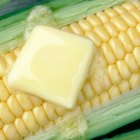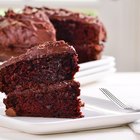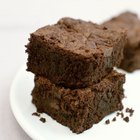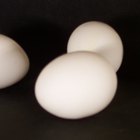
Cake emulsifiers are among a group of additives food manufacturers add to an array of prepackaged products. In parts of Asia, some emulsifiers intended specifically for baked goods are available to home cooks. Emulsifiers occur naturally in many substances you can add to your cakes and baked goods, and any of these can substitute for each other. One common cake emulsifier you might already have on hand is lecithin, derived from soy and present in soybean oil and soybean-based vegetable oil.
Natural Cake Emulsifier Substitutes
Some ingredients in cake recipes, such as eggs and oil, are emulsifiers in themselves. Emulsifiers perform a variety of functions. Their chemical interactions and reactions serve to break up fat into smaller particles, coat the fat particles to prevent them clumping, allow for the even distribution of these particles throughout another substance, and aid in the extended stabilization of fat, water and protein so as to create a smoother, more consistent and moister crumb.
Lecithin
Lecithin, derived from soy, present in soybean-based vegetable oil, is a natural emulsifier that moistens and improves the overall texture of cakes and baked goods. Cake recipes call for vegetable oil precisely for this reason, as do store-bought cake mixes. Lecithin is unique in that it contains substances that are both hydrophillic and lipophillic -- equally suspended in both fat and water simultaneously. Lecithin's ability to evenly fuse fat and water combinations accounts for its emulsifying properties. Because cake batter is an oil in water mixture, any cake batter to which lecithin is added receives the benefit of lecithin's function.
Borrowing Emulsifying Properties
Store-bought yogurt and sour cream contain synthetic emulsifiers. It's possible to "borrow" the emulsifying properties in these foods by adding them to cake batter. Muffins and cakes with added yogurt or sour cream are moister because of the added fat, the emulsifiers used in these products, and their ability to promote a creamier consistency. There are no hard rules or recommendations for adding exact amounts of yogurt or sour cream to cake recipes, though 1/2 to 1 1/2 cups are the most common measurements.
How to Use Lecithin as an Emulsifier
To use egg-based lecithin, add room temperature yolks one at a time to creamed butter and sugar while whisking or mixing constantly. Completely mix in each egg yolk before adding the next one. Lecithin intended specifically for baking is available in liquid and granular form. Substitute a small portion of the overall amount of required oil with lecithin, and add the remaining oil as well. Blend the cake batter well to sufficiently emulsify all the ingredients. Add 1 to 2 tablespoons of granular lecithin per 3 cups of flour.
Related Articles

Common Food Emulsifiers

Can I Make Boxed Devil's Food Cake Mix ...

Applesauce as an Egg Substitute for ...

How to Bake a Really Moist Boxed Cake

What Kind of Oil Do You Use in Brownie ...

Joico K-Pak Shampoo Ingredients

What Can You Substitute for Oil While ...

Can You Substitute Yogurt for ...

How to Make Homemade Lotion With ...

Aveda Shampure Ingredients

Do You Still Need Baking Powder & Salt ...

What Can You Use in Place of Egg Yolk ...
Water Substitutes for Cake Mix

The Ingredients in Jergens Naturals

Ingredients in a Curves Protein Shake

The Ingredients of Neutrogena Sensitive ...

Do Eggs Make Baked Goods Rise?

How to Bake a Cake Without Egg Whites

Ingredients in Hairfinity Vitamins

How to Bake an Eggless Cake With a ...
References
Resources
Writer Bio
Born in New York City, Tremaine Jackson has been in theater, dance and music since age 12, when he appeared in Liz Swados' "Swing" at the Brooklyn Academy of Music. He is also an award winning children's recording artist. He writes fiction and poetry in his spare time.
Photo Credits
Jupiterimages/Stockbyte/Getty Images